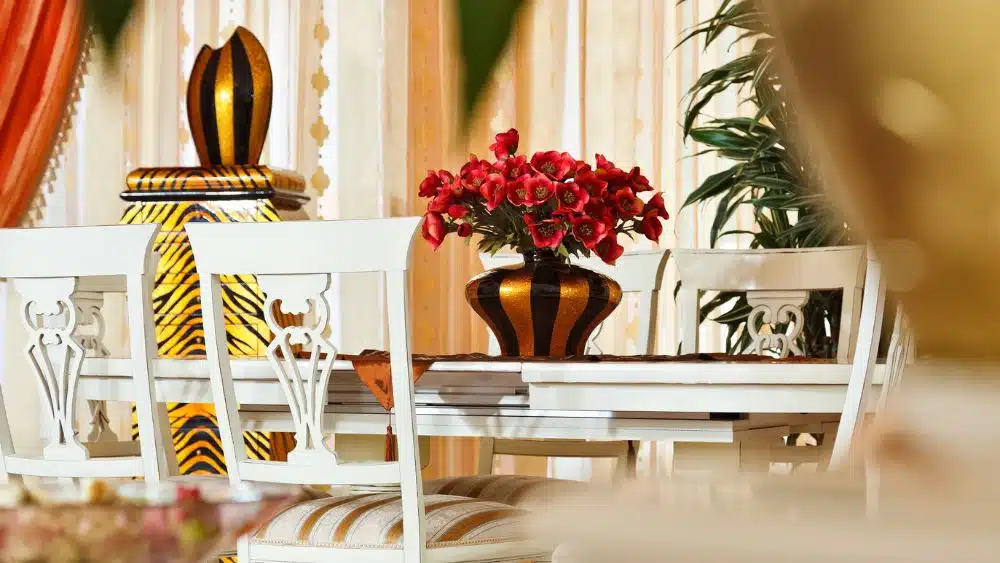
If ever there was a design style that could be categorized as flashy, it’s Art Deco. It rose to popularity during the 1920s and ‘30s and is all about style, glamour, and perceived opulence. Ironically, a mass-produced sensibility also defined Art Deco style, yet pieces tend to feel one of a kind. Art Deco celebrates man-made technology and progress unapologetically, and it has the smooth, polished surfaces to prove it. It’s a bit of a showoff, really, but for fans of its boldness, it’s not a flash in the pan so much as a flash of lightning that parks itself in your living room, sending shockwaves through your space.
What began as a decorative movement in France grew into a worldwide phenomenon that touched architecture, decor, and furnishings. Today, the largest concentration of Art Deco architecture in North America can be found in Miami’s South Beach neighborhood, where nearly 800 Art Deco buildings are within one square mile.
If all of this leaves you wondering, “Where do I start?”, here are a few guidelines to decorating in the Art Deco design style.
Distinguishing Elements:

- Strong Geometry: angular patterns, strong curves
- Heavy use of mirrors and mirrored furniture
- Iconic colors are black and white, though bright colors are used as contrasting accent color
- Sleek Surfaces: Lacquered wood, polished metal, glass and metal pieces
- Graphic patterns and sleek textiles in silk, vinyl, satin, etc.
Shine On
Reflective surfaces and lots of mirrors — the more, the better — are key to decorating in the Art Deco style. Glass with etchings, stained glass, lacquer, and polished wood are all perfectly suited for an Art Deco home, but most especially chrome, particularly when it comes to lighting. Another signature Art Deco lighting style is to pepper your space with Tiffany-style lamps. The stained-glass beauties were popular during the Art Nouveau period that preceded Art Deco and remained popular into the 1910s.
Think Big, Showy Pieces
Large furniture and plenty of it is another hallmark of Art Deco design. Black lacquered sideboards in dining rooms, armoires housing bar essentials in the living room, mirrored nightstands in the bedroom — if it’s large, flashy, and provides plenty of storage, it’s a win in the Art Deco world. The key to keeping an Art Deco home looking clutter-free, however, is to streamline your choices to the pieces you just have to have, so you end up with a curated jewel box that feels more like a collection of fine art.
Combine Different Textures

Leather couches paired with velour pillows, faux animal skin rugs, and polished surfaces are all great ways to decorate in the Art Deco design style. As mentioned earlier, anything polished and reflective is welcome, especially mirrored furniture that reflects light and makes spaces feel bigger.
Set the Mood with Lighting
Mood lighting is essential to the Art Deco style. Layered lighting with fixtures such as sconces direct light up or down to create a sultry and seductive glow. Shiny items and metals such as chrome and brass accent the sleekness of lacquered furniture, polished glass and metal accessories. Graphic patterns and sleek textiles make up most furniture designs and use materials such as vinyl, silk and satins. Patterns have geometric, rhythmic motifs and show a great amount of symmetry. While not the most common, animal prints can be used as well.
Look for Interesting Shapes

Geometric designs and patterns are key to Art Deco design. Examples include chevron patterns in rugs and tiles, sunburst mirrors, and plenty of sharp edges living side by side with curved seats the shape of crescent moons. Symmetry is also key to decorating in the Art Deco style, so it’s important to streamline furnishings so that nothing feels off balance.
Color Your World

Color in Art Deco is most commonly black and white due to their classic, timeless nature, though bright colors such as peacock blues and regal purples are seen as well. A popular option is to use primarily black and white and apply a bright, contrasting accent color.
The contrast of creamy whites and sharp black are the foundation of Art Deco design, but bold, bright colors are brought in for pops of fun. In Miami’s South Beach, for example, Art Deco takes a cue from the environment with lots of crisp, white furnishings and accents in bright, sunny shades. By contrast, Art Deco design in Europe tends to focus more on jewel tones. Either way, the juxtaposition of light and bright is the color contrast that sets Art Deco design apart.
Floors Are a Big Deal
It’s a lot to redo your floors if they don’t already align with Art Deco style, but they are like a canvas for this design style. Black and white floor tiles in entryways and living rooms and warm, woody parquet peeking out from under large, geometric rugs are all at home in Art Deco design. And while it’s not likely that anyone would want to make linoleum their kitchen flooring, it was part of the design style when it was most popular.
Look for High Art

Highly stylized art, especially anything architectural or focused on flora or fauna, are key to Art Deco design. From photographs of buildings in interesting shapes to hieroglyphics, the movement paid homage to great design, wherever it was found. But there’s also room for bold safari prints, too. In fact, leaves, branches, feathers, and exotic animals were all iconic motifs of the Art Deco period, so any artwork or accents that feature them will also work well.

Ana Connery is former content director of Parenting, Babytalk, Pregnancy Planner and Conceive magazines as well as parenting.com.
While editor in chief of Florida Travel & Life magazine from 2006-2009, she covered the state’s real estate and home design market as well as travel destinations.
She’s held senior editorial positions at some of the country’s most celebrated magazines, including Latina, Fitness and Cooking Light, where she oversaw the brand’s “FitHouse” show home.
Ana’s expertise is frequently sought after for appearances on “The Today Show,” “Good Morning America” and CNN. She has interviewed the country’s top experts in a variety of fields, including U.S. Secretary of Education Arne Duncan and First Lady Michelle Obama.
 Moving To Los Angeles? Our Relocation Guide Will Help
Moving To Los Angeles? Our Relocation Guide Will Help